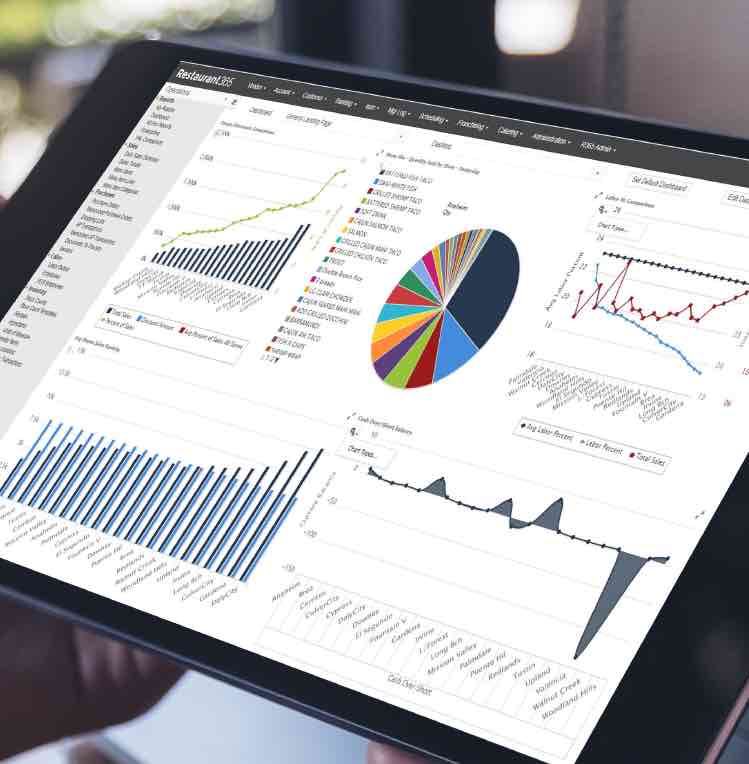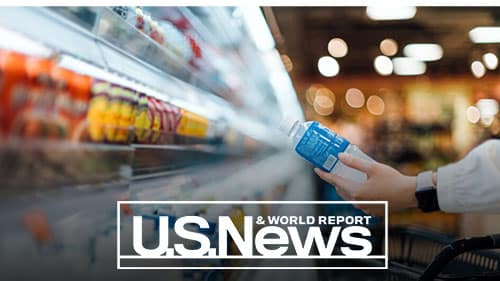Operating a restaurant group is unlike running any other type of business. From an accounting standpoint, restaurants are sometimes compared to manufacturers operating multiple retail locations. In both industries, raw items are purchased in order to create and sell an end item. But in manufacturing, there is a finite number of parts that go into building a car, for example, and that specific make and model is exactly the same whether it’s built in Mexico or Detroit. In the restaurant industry, no two Cobb salads are exactly alike.
There’s slightly less cheese in one and slightly more avocado in the other. Multiplied by the number of those menu items you sell in a month, it’s a challenge to keep track of the differences in the ingredients that go into each menu item and ensure that your restaurant business is making a profit. Additionally, restaurants have a large, fast-changing inventory with a limited shelf life, which also affects your bottom line.
Because restaurants face distinct operational challenges, restaurant accounting is a unique discipline. Typical accounting methods don’t meet the needs of restaurant businesses. Modern restaurant accounting methods depend on accurate and timely recording of financial data.
Tracking and measuring key restaurant metrics from your financial data can help you understand your business trends, stay competitive, and enable you to strategically act on future projections. With slim margins notorious in the restaurant industry, you not only need to increase revenue to stay profitable. You need to turn your focus on reducing controllable expenses, thus increasing profit by analyzing and optimizing costs using modern restaurant accounting.
Modern restaurant accounting
Because restaurants face distinct operational challenges, restaurant accounting is a unique discipline. Typical accounting methods don’t meet the needs of restaurant businesses. Modern restaurant accounting methods depend on accurate and timely recording of financial data.
Tracking and measuring key restaurant metrics from your financial data can help you understand your business trends, stay competitive, and enable you to strategically act on future projections. With slim margins notorious in the restaurant industry, you not only need to increase revenue to stay profitable. You need to turn your focus on reducing controllable expenses, thus increasing profit by analyzing and optimizing costs using modern restaurant accounting.
Whether you handle accounting in house or outsource it to a restaurant accounting firm, restaurant accounting requires meaningful analysis of your financial data to ensure ongoing profitability, and thus requires restaurant-specific professionals well versed in financials within the context of the restaurant industry and in the key performance indicators (KPIs) your restaurant group should focus on based on your business model.
Combined with human accounting expertise, modern restaurant accounting tools that “speak” restaurant can ensure that your financial professional is using modern accounting methods specific to the unique needs of your restaurant business in order to identify operational inefficiencies, profit leaks or trends that require action.
Modern restaurant accounting can help you:
Restaurant accounting basics
If you’re an owner/operator or other non-accounting restaurant professional responsible for the profitability of your restaurant business, you’ll need to master these four restaurant accounting basics – all of which can be automated using modern accounting tools – in order to fully appreciate modern restaurant accounting and leverage the expertise of your in-house or outsourced restaurant accounting professionals. All restaurant accounting starts with these four basic elements:
- Chart of accounts
- Restaurant expenses
- Prime cost
- Prime cost as a percentage of sales
Chart of Accounts
The chart of accounts is a listing of all accounts that are related to your restaurant business. Each and every transaction in your restaurant results in a change to the balance of at least two accounts. Your chart of accounts includes your assets, liabilities, revenue, expenses, and equity. The chart of accounts is the source of your restaurant’s financial statements, so it’s essential for getting insights into your revenue and expenses.
Restaurant Expenses
The success of your restaurant depends on many factors, including of course, sales. But your costs relative to sales are the most clear indication of the fundamental financial health of your restaurant business, so you’ll need to start with an accurate recording of your expenses.
Restaurant Accounting Divides Costs into Four Categories:
- Cost of Goods Sold (CoGS): also known as food cost, CoGS is the total cost of all food and beverage ingredients your restaurant used during a specific time period
- Labor costs: expenses associated with payroll, payroll taxes, and employee benefits
- Occupancy expenses: fixed costs such as rent, property taxes and property insurance
- Operating expenses: everything else it takes to run your restaurant, including laundry, equipment repairs, marketing costs or professional fees
Prime Cost
To calculate prime cost, you need to track two key metrics about your restaurant operations – CoGS and labor.
As previously stated, CoGS is the combined costs of food and beverage ingredients that were sold at your restaurant over a certain period of time. CoGS totaled takes into account the ingredients that make up your food and beverage sales. CoGS does not include one-time, non-inventory-related costs, such as refrigerator repairs or the purchase of a new oven. Because CoGS tracks ingredients, an accurate CoGS number depends on accurate inventory management figures.
Prime Cost to Sales Ratio
When you’re analyzing the financial health of your restaurant business, note that no single number tells the whole financial story. For example, a higher volume restaurant will usually have a higher prime cost than a smaller restaurant. It’s not relevant to compare the two restaurants because the larger restaurant is most likely experiencing higher sales than the small restaurant, just as it’s not relevant to compare the prime cost of a quick serve restaurant with a fine dining establishment.
So, another important figure you need in order to determine the financial health of your restaurant is your prime cost to sales ratio, using the following formula:
Prime Cost ÷ Total Sales = Prime Cost Ratio
Your prime cost to sales ratio contextualizes your prime cost by comparing it to total sales for a specific time period. Generally, the prime cost of a successful, sustainable restaurant business is approximately 60% of total food and beverage sales. A full-service restaurant will run a slightly higher prime cost (60-65%) than a quick service restaurant (55-60%). Other factors such as mix of product sales, pricing, operating hours, and level of food and service can impact both food and labor costs, thus affecting prime cost and prime cost ratio.
Modernizing your restaurant accounting
With the aforementioned accounting basics as the foundation of your restaurant accounting, and hence the success of your restaurant business, let’s dive into how you can modernize your restaurant accounting to impact your bottom line.
Modernize Your Chart of Accounts with Restaurant-Specific Categories
The other part of the prime cost equation covers the line items that make up your labor costs. These costs include the total hourly and salaried wages your employees and managers have earned during a specific period of time, plus payroll taxes, benefits, and insurance.A modern chart of accounts as part of a restaurant-specific accounting system enables you to record and track food and beverage purchases in detailed accounts (e.g., seafood, chicken, beer, wine, etc.) with automated invoice coding and entry, and direct feeds of POS data.
Additionally, modern restaurant accounting systems consolidate chart of accounts so that multiple locations and legal entities can be compared side by side. Even though transactions will be connected to individual locations, the accounts are made up of a uniform chart of accounts.
What’s your accounting cycle?
Your reporting periods must allow you to compare performance over time. Reporting by calendar month does not provide an apples-to-apples comparison because of the uneven number of weekend days in each month. Consequently, the optimal solution for restaurants is to set up reporting using 13 accounting periods of four weeks per year, or 4/4/5 accounting periods. The 4/4/5 calendar divides a year into four quarters of 13 weeks grouped into two 4-week months and one 5-week month. These cycles ensure the same number of each day in each period.
Many restaurant businesses opt for the 13 four-week cycles because consistent four-week periods can make comparisons of financial performance from period to period much more practical. If you run payroll weekly or bi-weekly, a 4-week period enables you to align your labor costs with sales, thus resulting in accurate labor cost calculations. The four-week cycle eliminates the need to accrue payroll if you have a bi-weekly pay period. Your P&L statements will then reflect 28 days of actual sales and 28 days of actual payroll.
Still, some smaller restaurants and even some accounting firms are resistant to non-monthly accounting cycles because of the monthly occurrences of such financial elements as bank statements, rent payments, and some taxes. The challenge is finding an accounting system that efficiently manages a restaurant group’s finances based on the company’s accounting periods and corresponding budgets. Old-school accounting solutions don’t recognize 13 four-week cycles or 4/4/5-week cycles, so manual workarounds are required.
Fortunately, some modern restaurant accounting platforms enable restaurant accountants to choose their accounting periods by monthly accounting cycle, 13 four-week cycles or 4/4/5-week cycles — with no painful exporting and manual tweaking of the data. For example, if you choose a monthly accounting cycle, but your utility bill runs from the 14th of one month to the 13th of the next month, a “date of service” feature in the software automatically calculates a daily cost for the utility and accounts for the proper invoice amount in each of the two months in your general ledger. Similarly, if you use 13 four-week cycles or 4/4/5-week cycles, your monthly utility bills are automatically and accurately recorded across the correct days.
Easily record error-free journal entries
Journal entries are done manually in spreadsheet applications, creating the likelihood of errors. And, most legacy accounting systems record certain data automatically when transactions occur, however, your accounting information may not be complete without manual additions to the data. If you need information that is not automatically generated and recorded as part of your transaction process, you may need to make a manual addition using a general journal entry. If accounting transactions are entered incorrectly or if a transaction should have been split into two different general ledger accounts, for example, the journal entry process requires you to make separate journal entries.
Next-generation restaurant accounting technology automates the journal entry process. Detailed data – including sales tickets, tenders, payment types, and clock-in/clock-out by job and employee – is pulled directly from your integrated POS system, then automatically creates daily sales and labor accrual journal entries for your accounting general ledger.Inventory also has its place in a modern restaurant accounting system. Every time a restaurant acquires, counts, transfers or wastes inventory, a journal entry is automatically created in the accounting software. For example, a completed stock count becomes the inventory journal entry.
Eliminate cumbersome intercompany transactions
If your restaurant business has multiple locations that are separate legal entities, legacy accounting programs require that you log in and out of different systems and databases, doing multiple journal entries for a single transaction spread over multiple locations, for example, a vendor invoice for fresh produce shared among several restaurant locations in the same city.
With modern restaurant accounting technology, the software will automatically generate any needed intercompany entries for different legal entities in a single transaction, increasing accuracy and saving hours of weekly accounting time. Entries are updated across all entities, eliminating the need to make multiple entries separately at the restaurant level. You can also record the transfer of resources between restaurants. There’s a centralized database, so transferring resources from location A to location B is automatically recorded across the system, eliminating the need for both locations to record the transfer. Intercompany transactions between one legal entity and another is built into the system and automatically recorded in the general ledger, allowing corporate to see what is happening at the store level.
Bring your general ledger into the 21st century with POS integration
A general ledger got its name because it was originally a physical binder or “ledger.” Today, a general ledger is still comprised of all the individual accounts needed to record the assets, liabilities, equity, revenue and expense transactions of a restaurant business, but it now takes many different forms, depending on the sophistication of a restaurant group’s accounting software. In spreadsheet software, which many smaller restaurants still use for their accounting, pivot tables summarize the data from the general journal and build the general ledger.
Legacy accounting systems not designed for restaurant accounting offer slightly more functionality by automatically categorizing the transactions to help identify errors if the credits and debits do not match. But, if there are accounting errors, it becomes necessary to dig into the general ledger and look at each recorded transaction to find out where and when the error occurred, which can be a cumbersome process.
In more advanced accounting systems designed for the restaurant industry, detailed data is pulled directly from your integrated POS system, then the accounting software automatically records the revenue, tenders, and discounts from the sales tickets in the POS system, then maps the sales and receipt details from the POS system to the general ledger accounts using sales accounts (credits) and payment type accounts (debits). It also automatically creates labor accrual journal entries for the general ledger.
Yes, bank reconciliation can be fun
Manual bank reconciliation can be a laborious process, with some restaurant groups reporting that it consumes about 20 percent of their accounting teams’ time. Technological advances now allow restaurant accounting platforms to seamlessly connect with financial institutions and automatically reconcile all bank activity in minutes.
When bank reconciliation is automated, you can identify discrepancies immediately, which means you can easily reconcile accounts on a daily basis – a practice that can dramatically reduce your financial exposure to payment errors and fraud while allowing you to immediately address any errors that do occur before they escalate.
One restaurant group CFO who switched from manual to automated bank reconciliation describes his experience: “I upload the bank data, go to the reconciliation, and everything’s already matched — there’s zero difference between the amount the bank says went out and what we said went out. I approve it and move on. It’s almost fun because I know that it’s going to get done so quickly and easily.”
Direct integration with your bank also allows you to track your bank deposits in near real time so you know almost immediately when they are processed by the bank and whether, for example, any deposits are missing.
Eliminate stacks of invoices with AP automation
A restaurant group can be tasked with processing hundreds or even tens of thousands of invoices each month. And if your restaurant business is managing accounts payable manually, you are faced with gathering stacks of invoices, entering each one individually into an accounting system, routing invoices through layers of approvals and ensuring that checks and electronic payments are issued correctly and on time.
Today’s restaurant accounting solutions with AP automation enable you to digitally upload, scan and process invoices in both electronic and hard copy formats and then automatically record them in the system for viewing and analysis by location, vendor, category and/or amount. You can actually have the invoice in the system on the same day you receive the food item.
Once in the system, invoices are digitally routed through the approval workflow, including multilevel approvals, according to specific rules that you establish up front, saving you countless hours of time each month.
Issuing payments is also an easy automated process with today’s restaurant accounting solutions, regardless of whether you are paying by physical check or ACH transfer – or even through a virtual card.
Get those receivables into your bank account and out of snail mail
While not usually as time consuming for most restaurant businesses as payables management, receivables management can eat a significant portion of your accounting team’s time. Automating the collection of receivables from catering, house accounts, franchising and other unique payment types can streamline the process.
For franchise brands, a next generation restaurant accounting system can pull sales data from franchise locations directly from the integrated POS system, then automatically generate royalty invoices and receive ACH bank transfers directly from franchisee accounts.
Modern restaurant technology can also pull sales data for house accounts from the POS, then automate the invoice and collection process. For unique payment types, such as those received from restaurant delivery services like Grubhub and Uber Eats, you can use a bank rule to automatically capture deposits.
Avoid surprises by tracking fixed assets
Tracking fixed assets is an important, yet often overlooked aspect of restaurant accounting. It’s essential for accurate budget planning to track and manage your fixed assets through every step of the asset lifecycle.
When you own a restaurant, you also own many fixed assets, such as real property, kitchen equipment, furniture, and more. Tracking each of these will help you estimate the lifetime costs of those assets. Modern restaurant accounting solutions that include fixed asset software can perform automatic depreciation, tracking their lifetime costs, including costs for repair and maintenance.
As your business grows, you can use fixed asset software to track the costs of aggregated assets during construction and then break those into individual assets once the store opens. If you transfer an asset to another location, advanced fixed asset software can calculate the cost of the asset for each store.
Take the headache out of budgeting
A restaurant budget keeps you headed in the right direction. You can’t know if your finances are on course if you haven’t set a course. Your budget is a hypothetical profit and loss statement (P&L) or balance sheet. It’s possible to do your budget manually or with generic accounting software, but modern restaurant accounting software automates the budgeting process for you.
With next-generation accounting technology you can easily budget for multiple locations at a time, automatically pulling data from your food and recipe costs, inventory and more. You can create budgets for both your balance sheet and your P&L. In subsequent years, you can reuse a budget from prior year actuals or start with a blank template.
You can create budgets with such parameters as:
- Current and future years
- Single location or multiple locations
- By period or week
- Fiscal or operational calendar
Make sense of all those numbers with automated financial reporting
Meaningful financial data about your restaurant is contingent upon its accuracy and timeliness. Generic, on-premise accounting software requires that you manually import your data from your POS system, thus making it unfeasible to track daily, or even weekly, not to mention its questionable accuracy. Running financial reports monthly only tells you what you did right or wrong last month, forcing you to be reactive rather than proactive in your decision making.
Keeping track of your financial data daily and ensuring its accuracy enables you to make immediate, data-driven decisions for your restaurant group. A modern restaurant accounting system can automatically collect and accurately organize financial data and transactions. This removes the time, effort, and many of the errors in the accounting process.
Advanced restaurant accounting technology, integrated with your POS system, pulls detailed records directly from the POS into the accounting system each time an integration is run, creating a daily sales summary that includes a journal entry transaction that records such details as:
Armed with this detailed data, you can run your balance sheet, profit and loss statement, comparative analysis by location, and more, on a daily basis. Analyzing your financial data daily empowers you to continually make data-driven decisions that affect your bottom line.
Optimize food and labor spend with automated operational reporting
Having immediate visibility into all the key drivers of your restaurant performance is a strategic differentiator for your successful operation. Real-time access to your operational data gives you the ability to generate actionable insights about your controllable costs – food and labor – giving you the opportunity to make adjustments in the moment.
Continually tracking your restaurant’s prime cost can create significant efficiencies in many different areas of your food and labor. Once you know your prime cost, you can analyze those numbers against your operations to decide where to streamline your business.
Some modern restaurant accounting solutions provide operational analysis reports, giving you detailed breakdown of a location’s sales by day part, service type, account, net sales vs. last year, last month and last week; guest counts and average check, cost analysis (purchases by cost account), key controllable expenses, and labor. Other useful reports offer side-by-side store costs by item or category; and vendor contract violations that can have a substantial impact on your food costs if left unchecked.
Still other reports allow you to compare what you spent on food and labor versus what you should have spent. For example, you can automate the entire process of tracking your theoretical and actual food costs to reveal the gaps in your plan versus your execution to help narrow the variance. Similarly, labor reports can optimize your labor spend by keeping daily tabs on your staffing costs. You can view data that enhances and forecasts the productivity and scheduling of your employees to help determine how labor has impacted sales.
Menu mix reports enable you to analyze selling price, cost and margins for menu engineering recommendations; see item profits to determine necessary price adjustments; and get sales/quantities by category, location or server to gain insights not gleaned from sales tickets.
If you’re still using generic accounting, you’re missing out on the opportunity to find leaks in your profitability and opportunities for revenue growth. These types of insights into your operations are only available using modern restaurant accounting tools.
That’s a wrap
Many restaurant businesses still do their accounting using plain vanilla accounting methods, usually with a combination of manual processes, spreadsheets, or generic accounting systems that lack restaurant-specific accounting functionality. But starting with a plain vanilla accounting system and adding expensive customizations and inefficient workarounds never attain the perfect “flavor” of accounting needed for a restaurant business. While it’s possible to run a profitable restaurant business using these outdated methods, it’s certainly not efficient.
Despite the unique challenges your restaurant faces, modern restaurant accounting can help you eliminate hours of manual work, gain visibility across your organization and reduce controllable expenses. Next generation restaurant accounting systems empower you to keep your restaurant running smoothly and your bottom line in the black.
Restaurant365 is a cloud-based restaurant accounting software platform that integrates with more than 90 POS systems, as well as food and beverage vendors, payroll providers and financial institutions. If you’d like to step up to modern restaurant accounting tools and methods, schedule a demo of Restaurant365.



